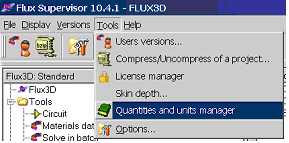Since version 2026, Flux 3D and Flux PEEC are no longer available.
Please use SimLab to create a new 3D project or to import an existing Flux 3D project.
Please use SimLab to create a new PEEC project (not possible to import an existing Flux PEEC project).
/!\ Documentation updates are in progress – some mentions of 3D may still appear.
Quantity and unit manager: about
Introduction
The quantity and unit manager allows:
- to have a list of the most current, usual quantities directly upon analysis (the list is different, in function of the treated application)
- to have the units associated to the quantity visible upon analysis (curve, calculation on a point, isovalues, arrows, exports of results…)
- to be able to choose the desired measurement unit for the analysis of his own Flux project
- to be able to add one measurement unit to one of the available default quantities
- to be able to define the personalized user quantities
These last three points should be carried out before opening and analyzing a Flux project, by means of the quantity and unit manager . This tool is accessible via the Flux supervisor.
Operating mode
The general operation of the manager of units is described in the table below.
| Stage | Description |
|---|---|
| 1 | The user opens the manager of quantities and units (access to the level of supervisor) |
| 2 |
For each of the accessible quantity at the postprocessor level (B, H, E, D, J, T, …) the user :
or
|
| 3 |
The software stores all this information in a dictionary (this dictionary is stored in the repertory of installation C:\Altair\Flux_N.N\Resources\UnityQty) |
| 4 |
The user opens Flux at his working repertory. At the postprocessing phase, all the sizes are displayed with the previously defined measurement unit (and stored in the dictionary) |
Access manager
Access to the Quantity and unit manager is carried out outside Flux starting from the Supervisor in the Tools menu.

The dictionaries
The quantities and units supervised via the Quantity and unit manager are saved in dictionaries totally independent from the Flux project.
These dictionaries are stored in the installation directory: C:\Altair\Flux_2018.0\Resources\UnityQty
These dictionaries are presented in the table below.
| Dictionary | Function |
|---|---|
| DefaultUnitiesQty.dico |
Reference dictionary 1: Quantities and units proposed by default |
| DefaultUnitiesZone.dico |
Reference dictionary 2: List of units by default for each unit systems considered (International and US) |
| CurrentUnitiesQty.dico* |
Current dictionary: Current quantities and dictionaries, defined by the user |
- If the user makes another change that he saves, the new saved dictionary will erase the previous one.
- Both reference dictionaries can’t be modified.
Exchange of dictionary between users
The current dictionary (CurrentUnitiesQty) can easily be transmitted between users, it suffices to copy* it in the directory C:\Program Files\Altair\2019\flux\Flux\Resources\UnityQty
Upgrade the dictionary
The dictionary of reference is totally independent from the software version, and is easily updated by Altair.
It will be possible to transmit this dictionary to users between two launches of versions/patches so that the user can benefit from the updates of the reference dictionary.
To this purpose, the user will have to replace the« old » reference dictionary by a new reference dictionary, when a new version becomes available.